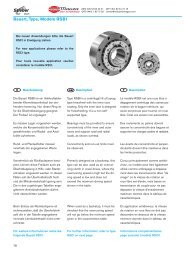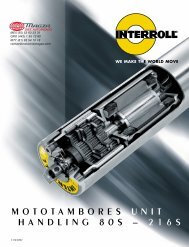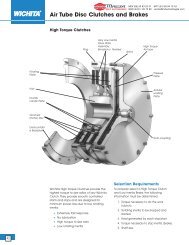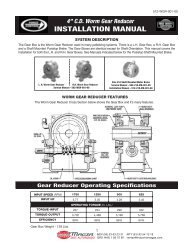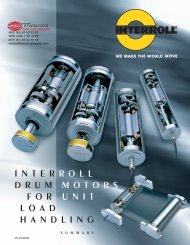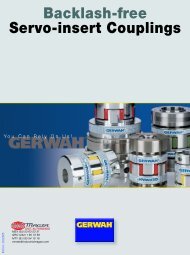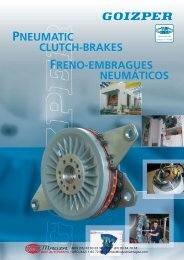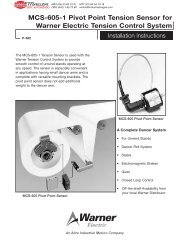Embragues y Frenos Mecanicos y Electromagneticos - Industrial ...
Embragues y Frenos Mecanicos y Electromagneticos - Industrial ...
Embragues y Frenos Mecanicos y Electromagneticos - Industrial ...
Create successful ePaper yourself
Turn your PDF publications into a flip-book with our unique Google optimized e-Paper software.
E M B R A G U E S Y F R E N O S M E C Á N I C O S Y E L E C T R O M A G N É T I C O S<br />
Mr. Clutch residual torque.- This is the torque<br />
transmitted by the clutch in the disengaged<br />
position.<br />
It depends on clutch position (horizontal or<br />
vertical), relative speed of plates or discs, oil flow<br />
rate and viscosity.<br />
With vertical assembly, the mobile frame or<br />
pressure plate, if it is not separated by springs,<br />
will be mounted at the lower position to prevent<br />
its weight from increasing residual torque.<br />
Par residual del embrague Mr .- Es el par que<br />
transmite el embraque en posición de<br />
desembragado.<br />
Depende de: La posición del embrague (horizontal<br />
o vertical), la velocidad relativa de las láminas o<br />
discos, de la viscosidad y caudal de aceite.<br />
En el caso de montaje vertical, la armadura móvil<br />
o plato de presión si no está separada por muelles,<br />
deberá montarse en la posición baja para evitar<br />
que su peso aumente el par residual.<br />
Mc. Load torque or static torque.- This is the<br />
torque required to overcome the work done by<br />
the machine and frictions. Its value is equal to<br />
the tangential force to be made multiplied by<br />
the length of the corresponding lever arm.<br />
M c = F • r<br />
Par resistente estático o par de carga Mc .-<br />
Es el par necesario para vencer el trabajo que<br />
realiza la máquina y los rozamientos. Su valor es<br />
igual al producto de la fuerza tangencial que hay<br />
que hacer, por la longitud del brazo de palanca<br />
correspondiente.<br />
M c = F • r<br />
Ma. Acceleration torque.- This is the torque<br />
required to accelerate masses up to a speed, in a<br />
required time. To work out this value the following<br />
formula is applied:<br />
M a =<br />
J(n 2 -n 1 )<br />
94 • t<br />
in daNm.<br />
J = Moment of inertia in kgm 2 .<br />
n 1 = priven shaft speed in r.p.m.<br />
n 2 = Driver shaft speed in r.p.m.<br />
t = Time in seconds.<br />
M a = Acceleration torque in daNm.<br />
In this formula all moments have to be referred<br />
to the clutch shaft, using the following formula:<br />
J red = J • i 2<br />
where J is the moment of inertia of the masses<br />
of a shaft at any given speed; J ref is the moment<br />
referred to the clutch shaft, and i is ratio between<br />
the former and the latter speeds.<br />
Par de aceleración Ma .- Es el par necesario<br />
para acelerar las masas hasta una velocidad en<br />
un tiempo deseado. Para calcular su valor se aplica<br />
la siguiente fórmula:<br />
M a =<br />
J(n 2 -n 1 )<br />
94 • t<br />
in daNm.<br />
J = momento de inercia en kgm 2 .<br />
n 1 = velocidad en r.p.m. del eje conducido.<br />
n 2 = velocidad en r.p.m. del eje conductor.<br />
t = tiempo en segundos.<br />
M a = par de aceleración en daNm.<br />
En esta fórmula todos los momentos tienen que<br />
ser referidos al eje del embrague, lo que se obtiene<br />
por la relación siguiente:<br />
J red = J • i 2<br />
siendo J el momento de inercia de las masas de<br />
un eje a una velocidad cualquiera; J red, el<br />
momento reducido al eje del embrague, e i la<br />
relación de velocidades entre el primero y el<br />
segundo.<br />
3<br />
DIST. AUTORIZADO<br />
®<br />
MEX (55) 53 63 23 31<br />
QRO (442) 1 95 72 60<br />
MTY (81) 83 54 10 18<br />
ventas@industrialmagza.com



